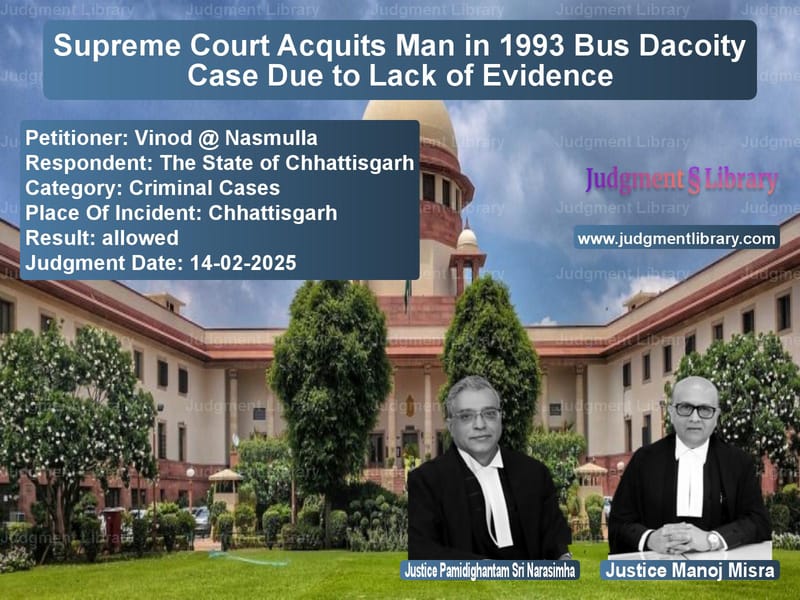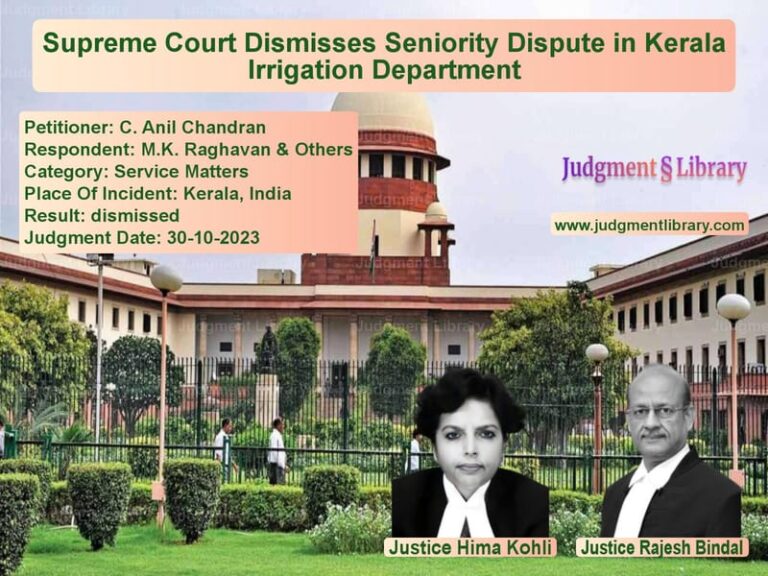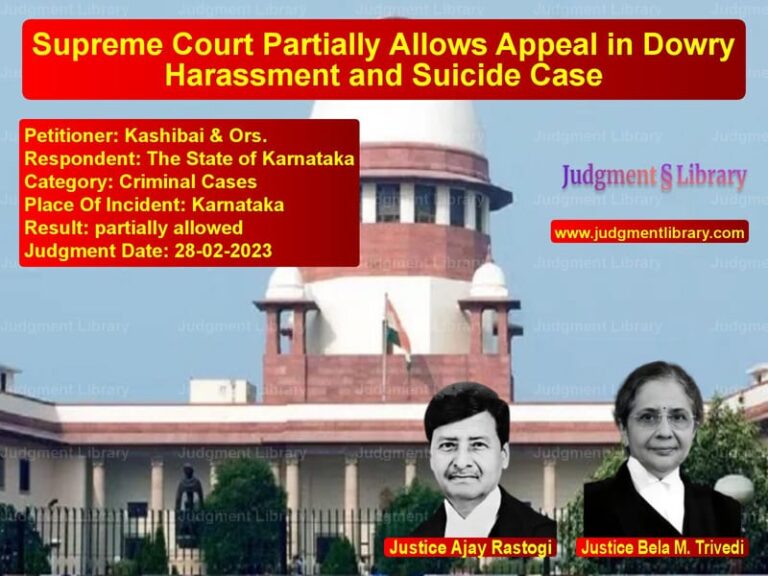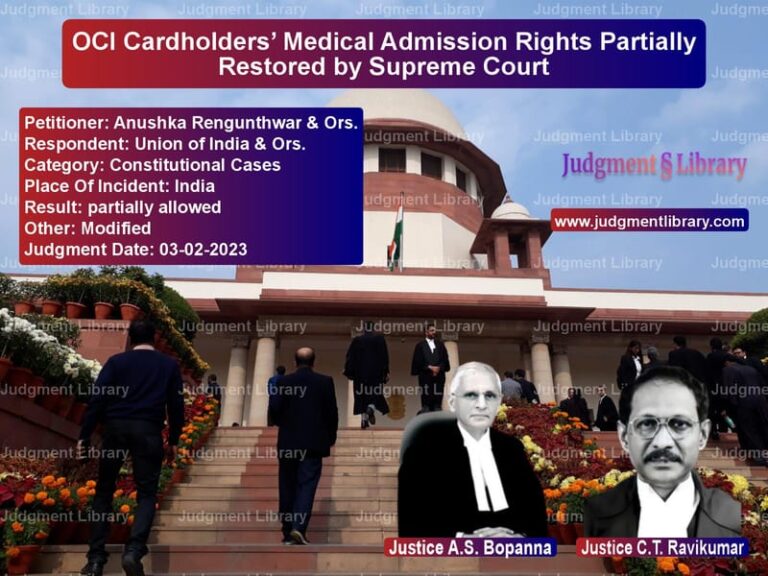Supreme Court Acquits Man in 1993 Bus Dacoity Case Due to Lack of Evidence
The Supreme Court of India recently delivered a landmark judgment in the case of Vinod @ Nasmulla v. The State of Chhattisgarh, acquitting the appellant of charges related to a 1993 bus dacoity. The ruling underscored the importance of proving guilt beyond reasonable doubt and criticized lapses in police investigation.
Background of the Case
The case stemmed from a dacoity incident on September 28, 1993, in which a group of armed men allegedly stopped a bus traveling to Raipur and looted passengers at gunpoint. The prosecution alleged that Vinod @ Nasmulla was among the culprits and was arrested the following night.
The trial court convicted the appellant under Section 395 (dacoity) read with Section 397 (use of deadly weapon) of the Indian Penal Code (IPC) and Section 25 of the Arms Act. He was sentenced to seven years rigorous imprisonment. The Chhattisgarh High Court upheld the conviction, leading to the present appeal before the Supreme Court.
Arguments Presented
Petitioner’s Arguments
The appellant contended:
- The prosecution withheld crucial evidence, including testimony from the bus driver and conductor, who had allegedly identified him in a Test Identification Parade (TIP).
- The only eyewitness who identified him in court, PW-9, was a police officer whose presence on the bus was unverified.
- No stolen articles were recovered from the appellant.
- The country-made pistol allegedly seized from him was not linked to the crime through forensic evidence.
- The manner of his arrest—alone at 3:00 a.m. by a single constable—was improbable.
Respondent’s Arguments
The State of Chhattisgarh argued:
- PW-9’s testimony was credible, and he identified the appellant as the person who put a gun to the driver’s head.
- The appellant was arrested within hours of the crime, with a loaded country-made pistol in his possession.
- The Test Identification Parade (TIP) conducted promptly after the arrest confirmed his involvement.
- The absence of stolen articles did not negate the conviction, as multiple accused were involved.
Supreme Court’s Observations and Ruling
The Supreme Court found serious flaws in the prosecution’s case and ruled in favor of the appellant.
Key observations by the Court:
- “The prosecution has withheld the best evidence, including the testimony of key witnesses who participated in the Test Identification Parade.”
- “PW-9’s presence in the bus is doubtful, and his non-participation in the TIP renders his dock identification unreliable.”
- “No looted articles were recovered from the appellant or at his instance, which weakens the prosecution’s case.”
- “The country-made pistol allegedly recovered from the appellant was not linked to any gunshots fired during the dacoity.”
- “The appellant’s alleged arrest at 3:00 a.m. by a single constable attending nature’s call does not inspire confidence.”
- “The seizure memo for the alleged weapon was prepared nine hours after the arrest, raising doubts about its authenticity.”
Final Judgment
The Supreme Court set aside the convictions under Sections 395 and 397 IPC and Section 25 of the Arms Act, ruling that:
- The prosecution failed to prove the appellant’s guilt beyond a reasonable doubt.
- Identification by a single police witness was insufficient without corroboration.
- The manner of arrest and weapon recovery was suspicious.
- The appellant was entitled to the benefit of doubt and was acquitted.
- As the appellant was out on bail, he was not required to surrender.
Impact of the Judgment
This ruling reinforces critical principles in criminal law:
- Burden of proof: The prosecution must prove guilt beyond a reasonable doubt, not merely raise suspicions.
- Importance of best evidence: Courts will not rely on selective witness testimony when better evidence is available.
- Fair identification procedures: The reliability of Test Identification Parades is crucial in criminal trials.
- Scrutiny of police claims: Courts must critically evaluate improbable arrests and suspicious recoveries.
The judgment is expected to serve as a precedent in similar cases where evidence is circumstantial, ensuring that no individual is convicted without proper judicial scrutiny.
Petitioner Name: Vinod @ Nasmulla.Respondent Name: The State of Chhattisgarh.Judgment By: Justice Pamidighantam Sri Narasimha, Justice Manoj Misra.Place Of Incident: Chhattisgarh.Judgment Date: 14-02-2025.
Don’t miss out on the full details! Download the complete judgment in PDF format below and gain valuable insights instantly!
Download Judgment: vinod-@-nasmulla-vs-the-state-of-chhatti-supreme-court-of-india-judgment-dated-14-02-2025.pdf
Directly Download Judgment: Directly download this Judgment
See all petitions in Bail and Anticipatory Bail
See all petitions in Fraud and Forgery
See all petitions in Judgment by P.S. Narasimha
See all petitions in Judgment by Manoj Misra
See all petitions in allowed
See all petitions in supreme court of India judgments February 2025
See all petitions in 2025 judgments
See all posts in Criminal Cases Category
See all allowed petitions in Criminal Cases Category
See all Dismissed petitions in Criminal Cases Category
See all partially allowed petitions in Criminal Cases Category







